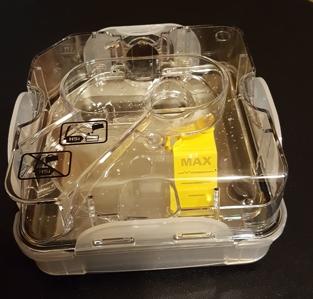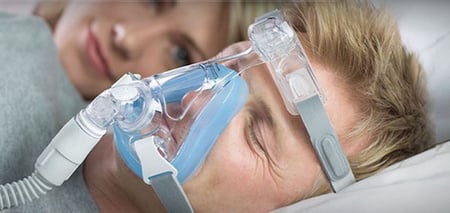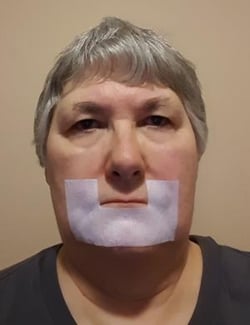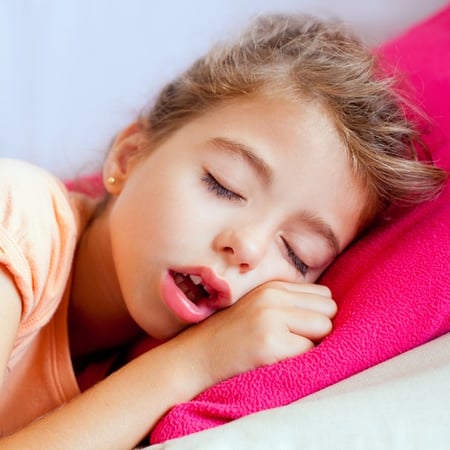CPAP Masks and Problems with Mouth Breathing
Continuous Positive Airway Pressure (CPAP) is the gold standard treatment for obstructive sleep apnea. The pressurized air moves from the CPAP machine, through a hose into a mask, where the air then enters the patient’s nose and mechanically splints the airway open, so oxygen can get into the lungs.
A mouth breather is a person who habitually inhales and exhales through the mouth rather than through the nose. When a patient sleeps with their mouth open, the air from the CPAP entering the nose will escape out of the mouth. This problem causes the CPAP pressure going into the airway to be less than is actually required to keep the airway open, thus reducing the efficiency of the CPAP therapy.
Heated Humidification
Usually the sleep doctor’s first go-to for resolving mouth dryness and mouth breathing is the use of heated humidification. Specially designed humidifiers such as this one can easily be installed into a CPAP machine.
Research on humidification goes back many years. In a study by Hayes in 1995, it was found that nasal CPAP that is used with an open mouth leads to an increase in nasal mucosal blood flux, which causes congestion. Hayes determined that this increased mucosal blood flux could be prevented by humidifying the air enterng the nasal CPAP.
A study in 1999 by Massie determined that heated humidification increases compliance with CPAP by reducing the side effects associated with upper airway symptoms and causing the patient to awaken feeling more refreshed after using CPAP with heated humidification. Massie suggested compliance gains may be realized sooner if patients are started with heated humidification at the initiation of CPAP.
A research study by Araujo in 2000 found that heated humidification significantly reduced air dryness occurring during CPAP, even during mouth leaks, and can be totally prevented by using a full face mask.
Full Face Masks
Since air escapes from the pressurized airway tract during mouth breathing, CPAP mask designers have addressed this problem by developing a full face mask. A full face mask is a triangular designed mask that covers both the nose and the mouth. That way, the air can enter either the mouth or nose and it will still keep the airway open. As stated above in the Araujo study, mouth dryness will be total prevented by using a full face mask.
 Even though full face masks are efficient in accommodating mouth breathing, they can be bulky and tend to leak because more mask surface is against the facial skin. People in general prefer a nasal masks which covers only the nose, but a nasal mask leaves the mouth available to open during sleep. Chinstraps are used with nasal masks to stop mouth breathing.
Even though full face masks are efficient in accommodating mouth breathing, they can be bulky and tend to leak because more mask surface is against the facial skin. People in general prefer a nasal masks which covers only the nose, but a nasal mask leaves the mouth available to open during sleep. Chinstraps are used with nasal masks to stop mouth breathing.
Chin Straps
Another popular go-to resolution for mouth breathing while on CPAP is chin straps. Chin straps are made of stretchable material that has Velcro attachments. Chin straps are designed to keep the mouth closed. Chin straps go under the chin and attach at the top of the head.
They can be effective, but the good ones are expensive. Problems arise because they can be uncomfortable and some of them have a tendency to cut across the ear, rubbing or intruding on sensitive tissue.
Because chin straps are made of stretchable material, they need to be tightened, sometimes significantly, to keep the mouth closed during sleep. The more pressure that needs to be used to close the mouth, the more the chin is pulled posteriorly. This causes the jaw to be pulled toward the throat, increasing the risk of the airway becoming restricted as a result of the receding chin. Chin straps that are made of non-stretchable material may be more effective at keeping the mouth closed in its natural position.
Chin Up Strips
Keeping  your mouth shut can be an arduous task sometimes! Some inventors, knowing that chin straps don’t work on many people, came up with a U-shaped adhesive tape strip that they claim keeps your mouth shut. It did an okay job when I tried it out, but it still allowed air to creep out of the sides of my mouth. I had to pull my facial skin tightly together to get the strip to keep my mouth shut completely. The device did work then, but it was a little uncomfortable on my face.
your mouth shut can be an arduous task sometimes! Some inventors, knowing that chin straps don’t work on many people, came up with a U-shaped adhesive tape strip that they claim keeps your mouth shut. It did an okay job when I tried it out, but it still allowed air to creep out of the sides of my mouth. I had to pull my facial skin tightly together to get the strip to keep my mouth shut completely. The device did work then, but it was a little uncomfortable on my face.
Mouth Taping
Taping your mouth shut by placing medical paper tape horizontally over the lips and past the corners of the mouth is a sure way of eliminating mouth breathing. Sounds weird, right? Yes, I agree, but It is a very effective resolution for mouth breathing. With the correct type of medical paper tape, it is painless and you will sleep much better and avoid medical problems connected with mouth breathing.
Problems in Other Areas?
It sounds like dealing with mouth breathing is a pain, right? In spite of your mouth breathing, if your CPAP is making you feel better than you were before CPAP, why bother with addressing the mouth breathing?
Causes and Results of Mouth Breathing
Mouth breathing, called xerostomia, is caused by various reasons. Nasal congestion, a cold, sinus/allergies and other environmentally caused conditions will resolve after a short period of time. Chronic mouth breathing caused by a deviated septum or facial bone structures, are best dealt with so nasal breathing can occur.
Breathing Through the Nose
It is natural to breathe through the nose. Life is dependent upon getting oxygen into our bodies. Air enters the nose where it is warmed, humidified, and cleaned, then goes into the lungs. Nose breathing makes us wake up feeling rested, it reduces high blood pressure and the risk of heart disease, reduces anxiety and depression, improves concentration and memory, reduces attention deficit and hyperactivity, relieves headaches, migraines, back pain, sciatica, and neuralgia, improves weight loss and digestion, strengthens your immune system and resistance to the common cold, and helps us perform athletically better than if mouth breathing.
Breathing Through the Mouth
As discussed above, mouth breathing reduces the effectiveness of CPAP treatment. In addition, mouth breathing causes many dental and medical problems.
In children particularly, mouth breathing is significantly associated with atopic dermatitis, the malocclusion of teeth, reduced chewing activity during eating, propensity to gum disease, speech impediments, improper facial growth and development, longer and more complicated braces treatment, and tongue-tie phenomena.
In general for both children and adults, mouth breathing causes dry mouth which means saliva is not in the mouth. The teeth being bathed in saliva helps resist cavities. When the mouth is dry from mouth breathing, the mouth pH drops to acidic levels. Both a lack of saliva and a lower pH cause a higher risk of developing cavities. And you can get bad breath from mouth breathing.
Sinuses produce 25% of the body’s nitric oxide during nose breathing. Nitric oxide increases the lungs’ ability to absorb oxygen, kills bacteria, viruses and other germs, enhances memory and learning, regulates blood pressure, reduces inflammation, and improves the immune system. Breathing through the mouth eliminates much nitric oxide from helping us thrive.
Nose breathing eliminates the two pints of mucous the body makes every day. If you are a mouth breather, this mucous will not be eliminated, causing it to stagnate and cause infections, ear infections, and sinusitis.
Smell and taste are closely linked. If you are a mouth breather, this link is hindered and may lead to disturbances in your appetite and satiation levels, causing you to eat more than necessary in your pursuit for taste.
Your nose also has vital nervous system connections to your heart as well. Heart rate, blood pressure, and stress can be raised by mouth breathing.
Summary
CPAP is the gold standard for treating sleep apnea. Breathing through your nose is the natural and optimal way to intake air. There are numerous advantages of nose breathing, and several disadvantages to breathing through your mouth.
If you breathe through your mouth, the air coming into your nose from the CPAP will just exit immediately out of your mouth, diminishing the effectiveness of the CPAP therapy.
For chronic mouth breathers whose condition is due to structural problem, surgery may be recommended. For others, mouth breathing can be eliminated or at least reduced by the various techniques or devices discussed above.
Sources:
Maria Teresa Martins de Araújo, Heated Humidification or Face Mask To Prevent Upper Airway Dryness During Continuous Positive Airway Pressure Therapy, Chest. 2000;117(1):142-147.
Clifford Massie, Effects of Humidification on Nasal Symptoms and Compliance in Sleep Apnea Patients Using Continuous Positive Airway Pressure, Chest. 1999;116(2):403-408.
MJ Hayes, Continuous nasal positive airway pressure with a mouth leak: effect on nasal mucosal blood flux and nasal geometry. Thorax 1995;50:1179-1182
Comparing nose and mouth breathing during activity: http://lifespa.com/finally-research-nose-breathing-exercise/
H Yamaguchi, Association between Mouth Breathing and Atopic Dermatitis in Japanese Children 2–6 years Old: A Population-Based Cross-Sectional Study, PLOS One, April 27, 2015
HY Hsu, Decreased chewing activity during mouth breathing, Journal of Oral Rehabilitation, August 2012
Image Credits:
www.shutterstock.com









Leave a comment